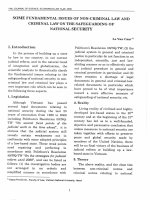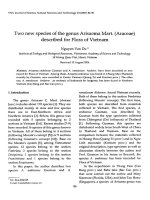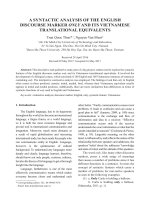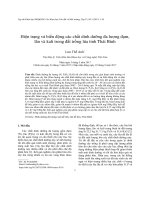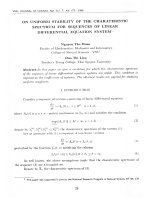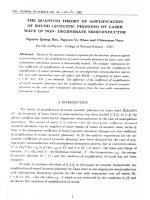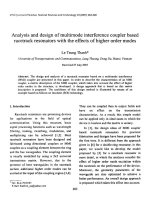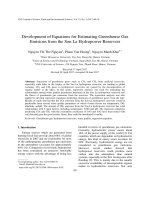DSpace at VNU: The quantum theory of amplification of sound (Acoustic phonons) by laser wave in non-degenerate semiconductor
Bạn đang xem bản rút gọn của tài liệu. Xem và tải ngay bản đầy đủ của tài liệu tại đây (3.91 MB, 6 trang )
VNU. J O U R N A L O F SCIENCE, Nat. Sci., t.xv r fil - 1999
T H E Q U A N T U M THEORY OF A M PLIFIC A TIO N
OF S O U N D (A C O U STIC PH O N O N S) B Y L A SE R
W AVE IN N O N - D EG EN ER A TE SE M IC O N D U C T O R
N guyen Q uang B au, N guyen Vu N h an and C h h o u m m N avy
FHciiIty o f Physics - College o f Natural Sciences - V N U
A b s t r a c t . Based on the quantum, transport
eq u a tio n
for the
electron - p h o n o n
system
o f s e m i c o n d u c t o r s , the a m p lific a tio n o f s o u n d (a c o u s tic p h o n o n s ) by L a s e r w a v e w ith
m u lH p h o to n a b s o r p t io n p ro ce ss IS th e o r etica lly stu died.
T h e a n a ly tic e x p r e s s io n s f o r
the co efficien t o f a m p lific a tio n o f s o u n d (a c o u s tic p h o n o n s ) a n d th e c o n d i t io n s o f
aTTi.plificat.ion of so u n d (acou stic ph on on s) in n on -degenerate se m ic o n d u c to rs an d in
the ca se w ith s u m m a t i o n o v e r all va lu es w ith m { n -
^ ~
a fr e q u e n c y o f L a s e r w a v e
i 2 . . J are obtained. The difference of the coefficient of amphfication
o f s o u n d ( a c o u s tic p h o n o n s ) a n d the c o n d itio n s o f a m p lific a tto n o f s o u n d ( a c o u s tic
p h o n o n s ) m the case w ith m u ltip h o to n a b s o r p tio n from, the case w i th m o n o p h o t o n
absorjition IS discussed.
I. INTRODUCTION
The tlieoiy of amplification of sound (acoustic phonons) by Laser wave ÊoSin(ÍÌỂ)
(ÍỈ - the frequency of Laser wave) in semiconductors has been studied [l 2 3]. In [1 2] the
physics problem was restricted for degenerate semiconductors in the case of monophoton
ahsorptioii Tho rpsnlts of works [1,^] iìuliraí-o that tho ahnoiption coofficicnt of aouiid
(acoustic phoiions) can bo negative in some regions of values of acoustic wave vector ỹ
That is t he absorption coefficient of sound (acoustic phonons) changes into the coefficient
of aniplificat.ion of sound (acoustic phonons). In [3] the analytic expressions for the absoiption roefhciont of sound (acoustic phonons) have been obtained for the case of non(legpneiate semiconductors with multiphotoii absorption process, but in restricted values:
A <$: k T q ^ Ị2ĩn^
^
k T and À
k T ( m and e - the mass and charge of
election ; A zr eEo/ĩĩiíì; k - the Boltzman constant ; T - the temperature; ujq- the energy
of acoustic phonoris (h = 1) ) and the condition of amplification of sound has not been
obtained .
In order to continue the ideas of [1,2,3 , in this paper we consider theoretically the
amplificat ion of sound (acoustic phonons) by Laser wave in non-degenerate semiconductors
with multiphoton absorption process (in the case with summation over all values
f — 0 ,± 1 ,± 2 ,.. .) for the value ujệ^ X which is not restricted by the condition in [3] and
we obtain the condition of amplification of sound.
N guyen Quaĩig Bail, N guyen Vii Nhati, ChhouTntn N a v y
2
II . T H E QUANTUM TRANSPORT EQUATION FO R PHONONS
Hamiltonian of electron-phonon system of semiconductors with the presence of Lasei
wave ẼQSÌniíìt) has the form
(
q
p
1)
p.9
where; a t and ap (6t and feq) - the creation and annihilation operators of electrons
(phonoiis); p - the vector of momentum of electron; c - the velocity of light ; Cq the
interaction constant of electron- acoustic phonon scattering; A{f) - the vector potential
(^_ k ịm ^Ể o S in m ).
Proceed from (1) and used method of [4,5,6] the quantum transport equation for
phonons in semiconductors with the presence of laser wave has the form
— --- 'ỉ^q{bq)t —
uf
Ujĩ-^) i
2
^
p
dt\{bq)t^X
./-00
00
exp {ii^p — ^p~q){^l —/) —i fi i ti + is ũ f } J ỹ {S^JsioQ)^
X
(2 )
f,5= —00
wherp: the symbol (.t)^ means the averaging of statistics of operator .t; np tK6 distribution
function of electron; 6 ịĩ the energy of election; ã = (eỂo/m íì^); Jf {z) - the Bessel function
with real argument.
III. AM PLIFICATION OF SOUND (ACOUSTIC PHONONS) IN NON-DEGENERATE
SEMICONDUCTORS IN M ONOPHOTON ABSORPTION PROCESS
By using th f Foiiiiei ti ansfonnation from (2) we find
oo
y
Jf{nq)Js{Õ-q}ĩlẶ^ + f^^^)Bq{uJ-m + síì),
(3)
f.s=.~oo
where
(4)
In the case of / = s from (3) we have dispersion pquation
oo
UJg) -
:5)
Cĩ
f=-oo
and absorption coefficient of sound (acoustic phonons)
oo
a((^ — ^ Cq- ^
(np- —'tf-p+q) è {£p-\-q —
f.=—oo
with 0(.r)- the Dirac delta function.
p
~
~
(6)
The Q u a n tu m Theory o f Amplification o f Sound ...
3
S 11Ị)Ị)US(‘ lliat tin* ai^unirat of the Bessel function is small so that aq = A/Q «c 1.
[
[loin suimnatioii to intoíỉ^ration over /7 in (6) the absorption coefficient of sound
(acoustic plioiious) for monophotoii absorption process (in the case with summation over
oal\' valui's (iĩ with / = 0, ±1) has the form
e x p ( 2 5 ,- w ,- í7 ) s h ( í^ |^ ) + exp(-2S,-w,-Q)
rxp
(7)
4777.'^
wlitne S(Ị — ììi/{2q^KT) ; no-íhe density of electron; ^ - the constant of deformation
potential: -s -volocity of sound ; p - the donsity of crvstal.
IÍ
we have a(íỹ))(). If ujự/íì
p.s \ 2 k T )
1 we have a(i 7)(() and which has the form
A
{m
sh
n
2kT
sh {2 S g u jA i)
.4 \ ■
X f‘xp
(8)
+
It uii-aiis tliat W(' have the coofficient of amplification of sound (acoustic phonoiis) .
IV AMPLIFICATION OF SOUND (ACOUSTIC PHONONS)IN NON-DEGENERATE
SEMINCONDUCTORS IN MULTIPHOTON ABSORPTION PROCESS
From ((j) we havo
0(^/1 = Trj CẬ
.jj(,uỊ)Y^n^{h{ep,^^^ - e,, -
^
f ——rxj
- m) -
- 6 f! +
- m )} .
p
(9)
\)ii used changing
d
In íli(' casp of X)ịì
fonniila in [6.7] :
F;
/ - --OC
n
( 10 )
7t(A'^ - 4 ) 1 / 2
VViK'lC
fì{z) =
1 if
2)0
0 if
z{ồ,
wo ha\'(’
( 11)
Passing fioni suniination to integration over 7? in (11) the analytic expression for
tlie absorption coefficient of sound (acoustic phonons) by Laser wave for multiphoton
absorption process (in the case with summation over all values fVt with / = 0, ± 1, ± 2 ,...)
is following
N g u y e n Q u a n g B a n , N g u y e n Vu N h a n , C h h o u m m N a iĩy
nii,A2
2qH'T
( III \>/2
exp
77?
2q‘H 'T
\ 2'
2 ĩìỉ
oc
— UJ,
i=n
,7!
|^(u;q-) - e x p ( - i l ) A ( - u j ạ ) j ,
where : A(u;q-) = (
OT (Ẻ
(
Ỉ
12 )
function with com-
plex argument; r ( 2 ) - the Gam ma function.
It is important to note th at the expression for the absorption coefficient of sound
(acoustic phonons) is calculated exactly by direct summation over all V'alues f n . FutliPimore. if
A{u,^)>
exp
(13)
we have a ( ^ ) 0 and if
(14)
A{u>ạ) < exp [ - ^ ) A { - U J ạ ) ,
we have a(if)(0 and which has the fonii
a { q )
=
-
Ỉ. I>0 ( ni \ 1/2
)
f'xp
2 ps \ 2 k T J
\
exp
I exp ( - ^ ) Ả(-U>ạ) - A(Wự-)| .
in
2qH-T V2 m
'V I
.;-0
J!
(15
It moans that we have again the coefficient of amplification of sound (acoustic phonons).
From the analytic fonimla (12) we make analyze the absorption coefficient of sound
in Ihuil
Lơậ ^
/ 2 ỉ t t , X ^ AT, ujq’ ^ AT aiiei
k \ ị T q ^ / 2 m tln u tlio iumiiiu nt of
the Bessel function is bigger than 1 , the summation only value j ~ 0 and lo(^) ^ c^y/2nz.
Om result for tho absorption coofficient of sound ill this limit cases is tho saiiK^ losiilt of
3].Not that if the condition of amplification of sound (14) is satisfied then tho absorption
coefficient of sound changes into the coefficient of amplification of sound.
We ninnorically evaluate and plot thf* analytic formula (7) for the casr of Iiioiioplioton absorption (Fig.l) and (12) for the caso of inultiphoton absoiption (F'ig.2) in the sanii'
condition. Thò absorption coefficient of sound (acoustic phonons) is plotted as a fuiK tion
of tho froqiu'ury of Laser wave (Q) and of the froquency of souml (acoustic phonon ) (ujy-).
From the graphics we can see
- For the nionophoton absorption : when UJ^/Q > 1 we have the absorption coi'fficient of sound (acoustic phonons) a{q) > 0.
- Ill the same condition for the case of multiphoton absorption wo have again tho
coefficient of amplification of sound (acoustic phonons) a{q) < 0.
Note that, the (lependonce of the coefficients of amplification of soinitl (acoustic
phonons) on the frequency of Laser wave (Í2) and on the frequency of souiul (acoustic
phonons) (iu’ỹ) is nonlinear and complicated.
The Q u an tu m Theory o f Amplification o f Sound ...
Mto®
OMEGA.ấ)dft
Fụj 7:Tho c oofficient of amplification of sound (acoustic phonons)
ill the case of inonophoton absoipfion
K- axis = (\{(])~ axis : o m e g a - axis =
- axis : O M E G A - axis = ÍÌ - axis
X 10
OMÊOA-w»s
a 0
/'/Ự 2 : TIh^ coi'fficifuit of amplifii'ation of soiiiul (acoustic phouons)
in th(‘ casi^ of Iiiult iphoioM ahsoi ptioii
S3- axis ^
HX I S I OlllGgii - iixis — i j j q - axis ; O M E G A - axis = Q - axis.;
V. CONCLUSION
In the conclusion, we want to (‘Iiiphasizo that :
1. The analytic expiossions for the' condition uJệ/íì
tho condition and coefficient of aiuplificatioii of sound (acoustic phonons) (14) , (15) in
Nguyen Quang Bau, N guyen Vu N han, C hhoum m N a v y
6
the case of multiphoton absorption arc obtained by us first tiiluv In tlio limit ( as(‘s
< kTq^/27n,Lj^ >
/2ni- and UJ^
kT. A > k T th(‘ absorption coefficient of
sound with multiphot.on absorption process (12) return to the rosult of [3 .
2. In the case of monophoton absorption (Section 3) : our results are different from
results of [1,2]. The reavSon of difference is th at results of [1,2] for the case of dogenorate
semiconductors, but our results for the case of non-dogeiierate seinicoiuliK tors.
3. In the multiphoton absorption (Section 4) : the expressions for the coiulition and the
coefficient of amplification of sound (acoustic phonons) (14), (15) show that tlie different
dependencies of that ones ill comparison with results of [1,2 and Section 3. The reason
of difference is th at results of 1,2] and section 3 for the case of monophoton absorption,
but. the expressions (14) and (15) for the case of multiphoton absorption.
A c k n o w le d g m e n t: We would like to thank the niomber of group of Theoretical Solid
s ta te Physics, Faculty of Physics , College of Natural Science , Vietnam National Univpisit v
for their discussions and the National Project on Basic Science K T 04 foi financial support
REFEREN CES
1] E.M. Epstein. Radio physics, 18(1975) 785.
2] E.M. Epstein. Lett. JET P, 13(1971) 511.
3 Nguyen Hong Son, G.M. Shmelev and E.M. Epstein. Izt). VUZOB S SS R J Physics.
5(1984)19.
41 D.K. Ferry and Carlo Jacoboni. Qĩiarứuin transport in semiconductors. New YorkLondon 1992.
5] G.M. Shmelev and Nguyen Quaiig Bail. Physical phenomena IĨÌ sennconductors.
Kishinev (1981)12.
6] Nguyen Quang Bau and Nguyen Van Huong. J. Science of HSU, Physics, 3(1990)
8.
7J L. Sholimal. lunnel effects in semiconductors and appb call OTIS. Moscow 1974.
TAP CHI KHOA HOC ĐHQGHN. KHTN. t.x v , vPl - 1999
LÝ THUY ET LƯỢNG T Ử VÉ SỰ GIA TANG SÓNG ẢM (PH ONO ÀM)
BỜI SÓNG LASER TRONG BAN DAN KHÒNG SUỴ BIEN
N g u y ễ n Q u a n g B á u , N g u y ễ n V ũ N h â ĩi, C h h o u m m N a v y
Khoa Vật ìý - Đại học K H Tự nhiên, ĐH QG Hà Nội
Tròn cư sờ phương tiìuli động lượng tiV do hệ điện tiV - phonon c ua hán (lan, ỉighi(Mi
cứu lý thuyết sự gia tầng sóng ảm (phonon âni) bờ sóng Laser có kể đốn quá trình hấ]^
thụ nhieu photon. Thu được biểu thức giải tích cho hệ số gia táng sóng ảni (phoiioii
âiiì) và đieii kiện gia tăng sóng âm (phonon ảin) trong trư ờ n g h ạp có kô đến tíiih toii^
theo tất cả các đại lượng chứa fíì{Q, — tần số sóng Laser, / — 0, ±1; ± 2 ;...). Thảo luận VP
sự khác nhau của hệ số gia tăng sóng âm (phonon âm) trong trư ờ n g hợp hấp thụ nhieii
photon so với trường hợp hấp thụ một photon
